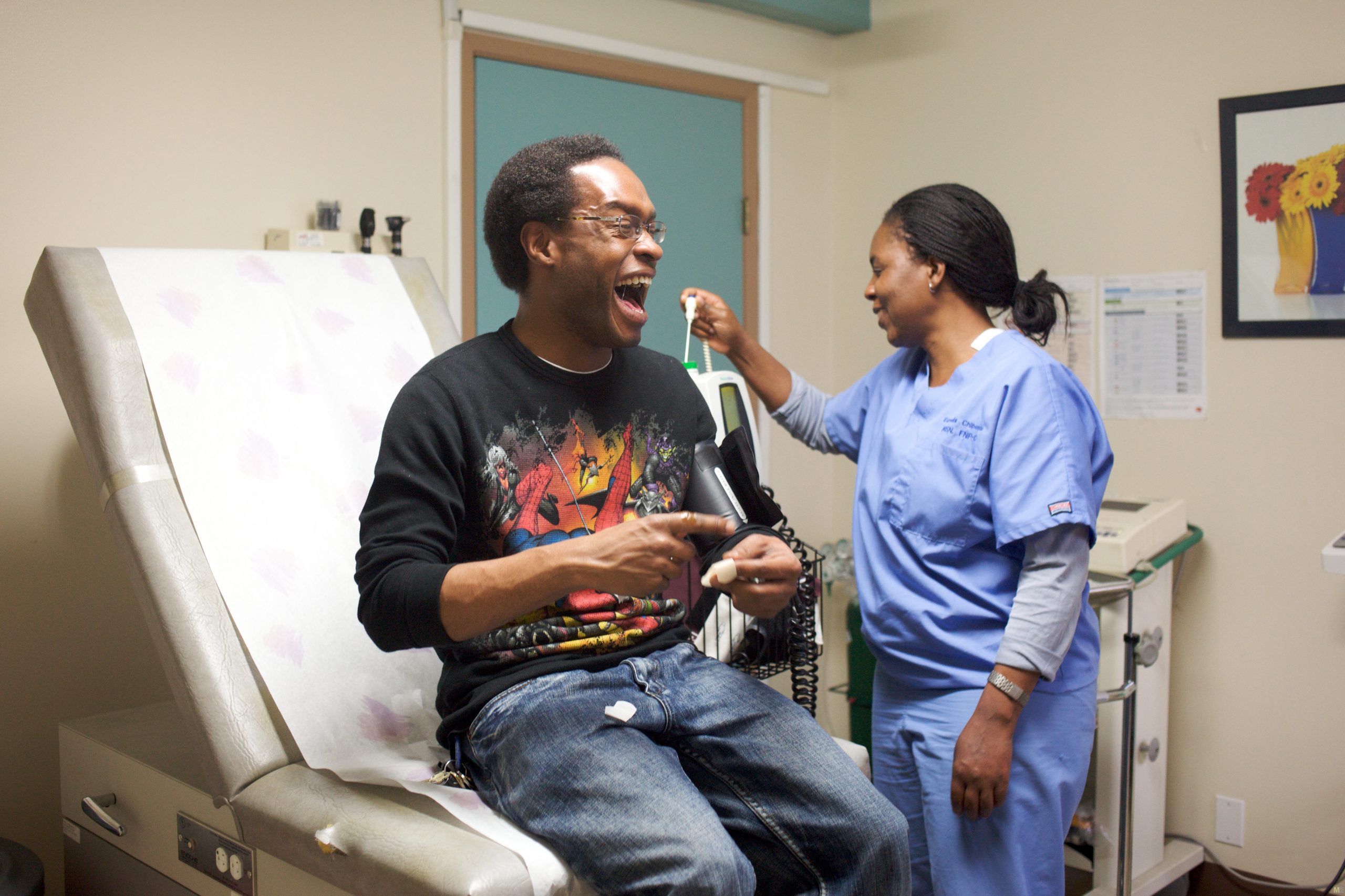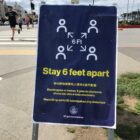As overall AIDS rates fall in Alameda County, the rate in the black community has hardly budged in the past 10 years, making African Americans in this part of the East Bay increasingly overrepresented among sufferers of the disease.
Public health experts disagree about why this is happening — behavior, education, stigma and lack of advocacy are all suspected. Which of these factors is most important will determine the best way to tackle the problem, and how to parcel out increasingly scarce resources in an era of growing state and local budget deficit.
To put the dilemma in perspective: African Americans make up 13.5 percent of Alameda County’s 1.5 million residents, yet they account for half of all AIDS cases reported there in 2008.
While the AIDS rate for African Americans in Alameda County has been more or less unchanged since 1994, the ratio of the black AIDS rate to that of all county residents has risen 42 percent.
Local officials and health experts have varying opinions as to why the gap between African Americans and other ethnic groups exists, and what to do about it.
“There is no mystery now about HIV infection, because we know how to prevent every single mechanism of transmission,” said Dr. Arthur Ammann, president of Global Strategies for HIV Prevention, a nonprofit dedicated to fighting HIV and AIDS overseas. “So why do we have more infections in minority populations in the United States? The problem is that it’s a disease related to sexual behavior, and it’s hard to change behavior.”
Ammann, who is also a clinical professor of pediatric immunology at the University of California San Francisco, is a pioneer in the field of HIV prevention. He has researched HIV prevention methods since the early 1980s, and was the first to discover two of the three ways HIV is transmitted.
He believes that the solution to Alameda County’s AIDS crisis resides beyond education.
“Does education change behavior? Not under these circumstances,” he said. “I think we are at the point where we have to say, ‘No, we must find out how to protect the people who are getting infected.’”
Conversely, some activists and public officials say AIDS education should be Alameda County’s highest priority for combating the high rate of AIDS among African Americans.
Kabir Hypolite, director of the Alameda County Office of AIDS Administration, said education is needed now more than ever, and he blames the high rate of AIDS among the county’s black residents on diminishing fear about the virus, blind trust in the success of anti-retroviral medications, and false impressions about who is at risk.
“It is still common for people to think that it’s gay white men that are catching HIV and AIDS, but it’s actually everyone’s problem,” Hypolite said. “At this point, there is no such thing as a high-risk group in my mind.”
Hypolite suggests that effective AIDS education in Alameda County begins with reaching out to groups that have not been mobilized, and working with community leaders who can relay the importance of AIDS education.
In addressing the widening AIDS gap between African Americans and other racial and ethnic groups in Alameda County, activists and county officials are placing AIDS education on the back burner, claiming that stigma is the primary issue to tackle.
Growing numbers of black residents are reluctant to get tested because HIV and AIDS are often associated with being homosexual or a substance abuser. As a result, late testing has become prevalent among Alameda County African Americans; many who seek HIV testing receive AIDS diagnoses.
Stigmas linked to cultural values keep people underground and make it more difficult to identify individuals in need of care and services.
“I know how it affects the people that we work with, but I worry about how it’s affecting the people who won’t come to us,” said Kevin Bynes, program director of AIDS Project East Bay, a nonprofit organization in Oakland that provides HIV and AIDS prevention and health services.
“We have not moved beyond judging,” said Hypolite, “so people will hide their status, will not know it, or will avoid getting care because they are afraid of being ostracized or shunned in some way.”
Activists and local officials seem to agree that lack of advocacy for black residents has compounded the ongoing AIDS crisis.
Some argue that methods that raised awareness about HIV and AIDS prevention in the past, especially in San Francisco and its gay community, have not carried over across the Bay Bridge.
They claim that demographics play a huge role in gaining public support.
Ammann said blacks have been part of the AIDS epidemic since the 1980s; however, the virus affected white males with political connections to AIDS advocates as well.
Loren Jones, an Oakland activist and African American woman who has been living with HIV for 25 years added, “In 1985, we were not getting information on this side of the Bay, because it was perceived that this disease was being spread through the gay, white male population, most specifically in San Francisco. That’s the kind of illogical thought process that leads to this backlog of people who are getting this disease — obviously that was a false premise.”
Jones, among other black AIDS activists in Alameda County, serves a vital role in raising awareness within the black community, and she rallies with her community in order to target county officials and make their issues visible.
“We have this whole idea that HIV and AIDS doesn’t have a face — it does have a face, and it’s black," Bynes said. "We have experienced no greater emergency as black people, and as a community, we need to get involved and do something."
While Alameda County’s public health dilemma persists, and experts remain divided about the cause of the problem, several advocates have presented possible solutions.
Ammann and Hypolite encourage practical methods to control AIDS infection rates. One method is partner notification.
Another is contact tracing, in which anyone who has been in sexual contact with an infected person is tested and treated.
Both have been problematic in the past because of the stigma associated with HIV and AIDS, but studies have shown they are effective means of outreach and prevention.
Public officials encourage Alameda County residents to remain persistent in lobbying for funding and policy changes in order to contain a public health dilemma whose end is long overdue.
SIDEBAR: LIVING WITH HIV
Interview by Gianmaria Franchini
Loren Jones, an African American Oakland activist who has been living with HIV for 25 years, talks about what needs to happen in the fight against AIDS.
On activism
It’s part of my survival, because I am a low-income African American woman myself – I always have been. I was born to a welfare mother, and have had in-and- out struggles with severe poverty.
My activism comes naturally to me. I was diagnosed with HIV more than 25 years ago, in ’85 or ’86. I don’t directly link the disease to race as much as I do to lack of knowledge. To see that the situation has continued, and has not improved that much for black women, is a major concern. For me it has been a 25-year struggle, and to see that information has still not reached people in a way that is empowering for them, I think is very disturbing.
My reason for being involved is that I really believe as individuals we can stop this. We can stop the madness.
I don’t think the public is aware of the numbers. People are not aware of a whole age group of women that are already dead. The fact is that AIDS is the number one cause of death for African American women 24-35 nationwide.
This is according to the CDC. Quite frankly, I think if it were white women, it would be on the news every day. Within any culture, these are a woman’s most productive years. These are not disposable people. To have them silently disappearing is not a good thing. America is a very proud country, and that is not something to be proud of.
On the role of education and poverty
When you are poor, you do what you need to do to survive. Unfortunately, and this is not just for black people, your worth as a sex object is marketable. I will say that I’m a fairly attractive woman. I’ve been homeless, and I’ve been on the street.
I’ve had men tell me, ”If I was a woman and I had what you had I wouldn’t be homeless.” And everyone knows what that means. That’s very sad, but it’s the truth of the matter. That’s pretty much where it’s at for black women. If you need something, you have to give something up, and the preference is sex. Of course, there is never any conversation about using condoms and protection.
On whether the black community has difficulty talking about AIDS openly
I think that has been the case. But I think that this is a generation that ought to be able to break that. People talk about sex in the media and in every other kind of way, so there is no reasonable explanation for why we cannot talk about protecting yourself from this disease.
On why African Americans suffer from AIDS disproportionately
That is the case. I am not going to be one to deny these numbers, although I do question them. I don’t know that we’re clear that these numbers reflect everyone that needs to be tested. The testing is pushed to target groups that are perceived as high risk. If you are a white woman who has not had many sexual partners, or who lives in a small town somewhere even in California, your white doctor is not going to suggest the possibility of an HIV test, because he doesn’t believe you are at risk. Whereas if you are a black woman and you look and dress a certain way, you will be perceived as high risk.
On what the statistics indicate
I think that they are irrelevant, because they give the perception that the virus is spread by race. AIDS is a disease that passes from person to person through unprotected sexual contact. This isn’t a situation where white people are just having sex with white people, and black people are having sex with black people.
Even the questions on surveys and CDC reports, they do not ask the race of the people someone has had sex with. They ask if you are HIV positive, if you shared a needle, if you had unprotected heterosexual or homosexual sex and so forth.
If I am a heterosexual black woman, the natural assumption is that the person I have had sex with is a black man. I have two daughters, their fathers are white.
In ’85 we were not getting information on this side of the Bay, because it was perceived the disease was being spread through the gay, white male population, most specifically in San Francisco.
That’s the kind of illogical, pseudo-scientific thought process that leads to this backlog of people who are getting this disease, according to ’statistics,’ they should not have the disease to begin with. Obviously, that was a false premise. Nobody was looking for it over here.
On whether women have a strong voice or figures who give them a strong voice when it comes to this issue
Yes, we definitely do. The organization that I work with, WORLD (Women Organized to Respond to Life-Threatening Diseases) was founded in 1991 by Rebecca Denison in her apartment. She was shocked to find out she had this disease, and also that there was no information about it that related to her as a woman.
For a woman, particularly a young woman who has not yet had children, a sexually transmitted disease is devastating and very serious. Any woman would want answers and expect them to be there immediately, and at that time, there were no answers for her. Doctors were not even comfortable talking about it. Now things are different.
On what needs to happen
It has to stop. Our preference is a cure. Even if we don’t have a cure, the message is so simple: You have to use protection no matter who you have sex with or how you have it. The message here in Oakland is, “AIDS stops with me.” It’s very clear.

Gianmaria Franchini contributed reporting to this story. A version of this article was published in the summer 2010 pilot edition of the San Francisco Public Press newspaper. Read select stories online, or buy a copy.










